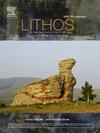Six olivine inclusions in diamond are remnants of a syngenetic monocrystal
IF 2.9
2区 地球科学
Q2 GEOCHEMISTRY & GEOPHYSICS
引用次数: 0
Abstract
We report the discovery of a diamond containing six thin, flat olivine inclusions. Cathodoluminescence (CL) imaging and X-ray tomography revealed inclusion alignment within and parallel to a single diamond growth zone. A novel application of Fourier Transform Infrared spectroscopy to diamond inclusions established that they shared a common crystallographic orientation. Whilst the olivine (100) and diamond (111) planes were parallel, the olivine b- and c-axes were not parallel to any of the diamond's major crystallographic axes. The shared morphology, spatial distribution and crystallographic orientations of the inclusions can only be explained by a single crystal origin, which has previously been used as proof of protogenesis. However, unusual CL dead zones, thought to be related to the partial dissolution and replacement of the monocrystal, are exclusively observed in the plane of the inclusions, implying that the original crystal was never equant when interacting with the diamond. As we are not aware of any mechanism resulting in olivine independently adopting such a high aspect ratio (over 60:1) in the mantle, we favour a model wherein the monocrystal grew as a thin layer on a pre-existing diamond surface before being partially dissolved and rapidly encased. We therefore conclude that the olivine inclusions are remnants of a syngenetic monocrystal, and that crystallographic orientation alignment between inclusions does not always imply a protogenetic relationship.

求助全文
约1分钟内获得全文
求助全文
来源期刊

Lithos
地学-地球化学与地球物理
CiteScore
6.80
自引率
11.40%
发文量
286
审稿时长
3.5 months
期刊介绍:
Lithos publishes original research papers on the petrology, geochemistry and petrogenesis of igneous and metamorphic rocks. Papers on mineralogy/mineral physics related to petrology and petrogenetic problems are also welcomed.
 求助内容:
求助内容: 应助结果提醒方式:
应助结果提醒方式:


